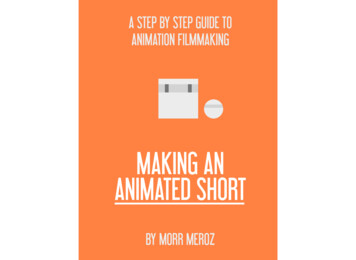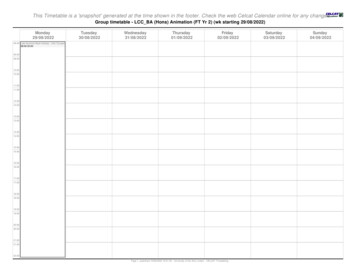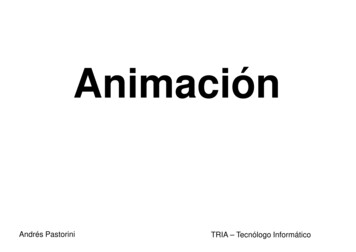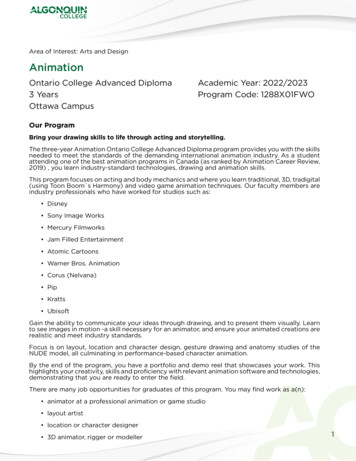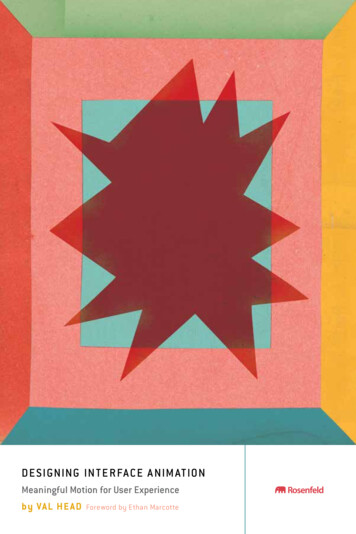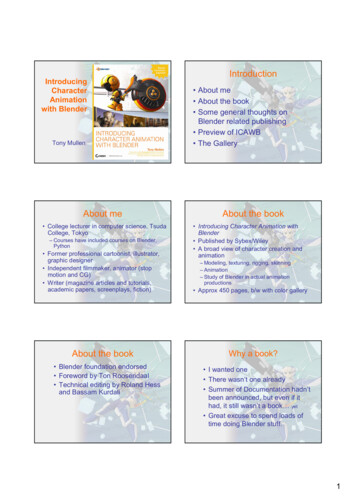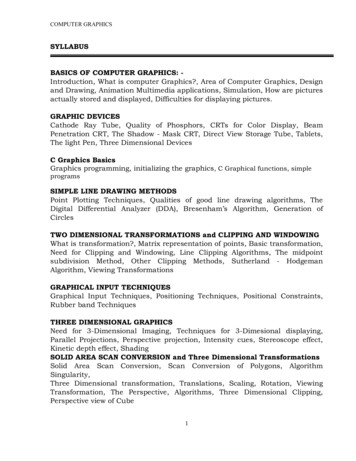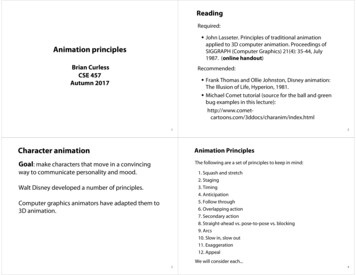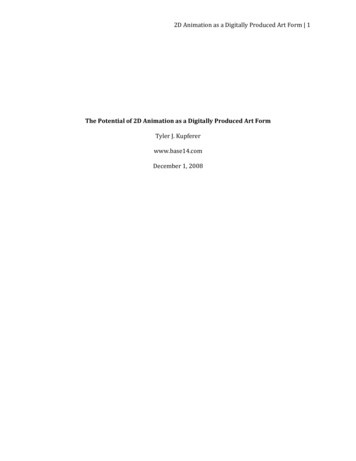
Transcription
2D Animation as a Digitally Produced Art Form 1The Potential of 2D Animation as a Digitally Produced Art FormTyler J. Kupfererwww.base14.comDecember 1, 2008
2D Animation as a Digitally Produced Art Form 2The computer graphics imagery revolution of the past decade has brought 3D animationto the forefront in Hollywood cinema, leading to the popular opinion that 2D animation isobsolete. However, digital animation techniques are giving rise to a new incarnation of 2Danimation as a digital art form. The quality, accessibility, efficiency and vitality of digitalproduction allows for new styles of 2D animation not possible before the advent of computergraphics. Computers allow for entirely new ways of producing, managing and enjoying animatedfilms. Much of the public sees 3D animation as the product of this digital revolution, andanything else as obsolete. But 3D animation is only half of a larger digital revolution for all formsof animation. The success of 3D has led to a major oversight of the potential for 2D animation ina digital medium. This potential will begin to be realized in the coming years as digital 2Danimation processes mature and rising artists push the boundaries of innovation that digitalproduction systems allow.BackgroundWhile many pioneers of animation were dabbling in film and drawings during the late1800s, the first true example of American animation is by James Stuart Blackton, who wasintroduced to filmmaking by Thomas Edison. Blackton produced several pieces combining liveaction with some stop‐motion animation, and eventually made Humorous Phases of Funny Faces(Fig. 1), featuring stop‐motion shots of drawings on a blackboard. It is often considered the firsttrue animated film. Animation techniques quickly developed thanks to contributions ofadditional pioneers like Émile Cohl, Winsor McCay and Walt Disney. Within 30 years, it hadsolidified as a specific art form.Throughout the 20th century, Animation as an art form had split off into a wide range ofstyles and techniques. 2D animation was the flagship of the industry since its tighter controlallowed for fluid movement and lively character performances. The development of “limitedanimation,” or animation that is styled not to follow a realistic approach, allowed 2D animation
2D Animation as a Digitally Produced Art Form 3to be produced at a practical speed and cost for mass distribution on television. Meanwhile,stop‐motion animation languished as a distant second to 2D. Although it offered the advantageof not requiring continuous redrawing of characters, the technique produced stiff, chunkymovement and required more capitol to build sets and characters.During the 80s, computer graphics imagery began to emerge as a new tool for producingspecial effects in film and television. Industrial Light and Magic, the company founded by GeorgeLucas for producing special effects in Star Wars, established a CGI department in 1979 forproducing effects in his films. This computer graphics department was eventually sold to SteveJobs in 1986. Dubbed Pixar, it set out as a computer hardware company selling CGI systems togovernment and medical organizations. Pixar began producing short CGI animations todemonstrate the uses of their hardware and submitted the shorts to SIGGRAPH, proving thepracticality of CGI animation. In 1995, Toy Story was released, marking the first fully CGI featurefilm in the history of animation. The success of Toy Story and subsequent Pixar movies provedthat 3D animation was a viable technique for the entertainment industry, and by the early2000s, several other big studios adopted the technique with their own 3D animationdepartments. This shift in attention to 3D animated films caused a steep decline in 2D animationprojects. As of today, Disney has not released a 2D animated film in theaters since 2004.A Comparison of 2D and 3DCurrently, 3D animated feature films dominate the box office. A popular opinion existsthat 2D animation in cinema is an obsolete technology, inferior to 3D animation. This had lead toa major oversight regarding the relationship between 2D and 3D animation styles and how theyhave transitioned into a digital world. It is true that digital 3D animation does have someadvantages over traditional 2D animation, but to compare these two animation techniquesdirectly is a bit short sighted.
2D Animation as a Digitally Produced Art Form 4What the majority of the public does not realize is that 3D animation is moreappropriately compared to traditional stop‐motion animation because it is, essentially, a digitalrecreation of a stop‐motion production process. It is ironic that the most popular type ofcinematic animation today is based on the techniques that languished in the background formost of the past century. In a 3D realm, characters are modeled and rigged very similarly tostop‐motion figurines. Just as in stop‐motion, the characters are placed in environments withcameras and lights, and the world is animated frame by frame to create the illusion of motion.The only major difference between stop‐motion animation and 3D animation is that with 3D, theentire set exists digitally. The extreme control over this digital reality allows for movement andaesthetic qualities never before possible in stop‐motion. CGI was such a huge step forward forstop‐motion that it was hard to draw obvious connections, and gave 3D animation a moreunique identity as an entirely new form of animation.This elusive connection can be demonstrated by analyzing the 2006 animated filmFlushed Away (Fig. 2), a collaboration between Aardman Animations and DreamworksAnimation. Aardman, of Wallace and Gromit fame, has a long reputation as a modern, successfulstop‐motion animation studio. During the production of the feature film Flushed Away, thesignificant role of water in the story presented a problem for the stop‐motion techniquesnormally used. Water is particularly difficult to film in stop‐motion and can easily damage theplasticine character models. In order to avoid major production problems, Aardman decided tocreate the entire film using modern CGI animation. Artists created the digital character modelsdirectly from the plasticine models, and in order to more fully emulate a stop‐motion feel,animators did not add motion blur to the mouths of the speaking characters. What resulted wasa movie that looks and feels a great deal like Aardman’s previous stop‐motion work, but iscompletely digitally created. When compared to Aardman’s most recent stop‐motion feature,Wallace & Gromit in The Curse of the Were Rabbit (Fig. 3), the similarities are numerous. The 3D
2D Animation as a Digitally Produced Art Form 5space is clearly defined with photographic depth of field and volumetric shading on figures. Bothfilms also feature similar usage of bright colors and three‐point lighting systems. Whencomparing still frames, Flushed Away has a slightly smoother, softer look, while Wallace & Gromitin The Curse of the Were Rabbit has a grittier appearance; the real‐world set has a more complexinterplay of shadow and ambient light, and the models feature more erratic textures with agreater degree of real‐world imperfections not duplicated in the CGI film. Overall, though, theyare very much alike.Still, Flushed Away is about as close as 3D animation comes to stop‐motion. Thetechnology has begun to diversify since its creation as artists explore the range of styles possiblein the medium. Compare the Aardman aesthetic of Flushed Away to the photorealistic style ofFinal Fantasy: The Spirits Within (Fig. 4), the wooden marionette style of Star Wars: The CloneWars (Fig. 5) or the cel‐shaded comic style of Waltz with Bashir (Fig. 6). Each style attempts toemulate a particular kind of aesthetic found in other genres of art. As research expands, newkinds of 3D rendering algorithms allow for these new artisitc styles. As with traditional forms ofanimation, artists will instigate research and development as they search for new ways to realizetheir creative visions.While this multitude of aesthetic styles seems quite diverse, it is the motion of thecharacters that connects them all as digital 3D entities. Returning to the comparison of FlushedAway and Wallace & Gromit in The Curse of the Were Rabbit, 3D animation takes a huge stepaway from its stop‐motion counterpart once the characters move. Compared to stop‐motion, thecontrol and precision of digital 3D animation with this technique, when done well, allows it toproduce much more convincing motion and immersive worlds for an audience. This was theappeal that caused traditional 2D animation to outshine stop‐motion, since its 2D plane allowedartists to create smoother, more appealing motion without worrying about a third dimension. Ifdigital animation is not done well, however, it will show in the characters’ unnatural movements
2D Animation as a Digitally Produced Art Form 6caused by the linear tweening of the computer. This same problem exists in digital 2D animation,when automated tweening is applied to 2D transitions.Just as stop‐motion animation has found new life in a digital medium, traditional 2Danimation has a digital equivalent. The real issue is that the disparity between the appearancesof traditional and digital is much less, although this could change in time. With 2D animation, aset is not built nor is a character rigged (in most cases). Instead, everything is directly created inthe realm of the visual plane. The transformation of stop‐motion into a digital realm of 3Danimation can be just as significant for 2D animation, but it has yet to be completely realized.QualityDuring the past two decades, digital techniques have slowly been changing the way thattraditional 2D animation is produced. In the late 80s, Disney and Pixar had developed theComputer Animation Production System, a large collection of hardware and software designedto computerize the post‐production process of cel animation, making all inking, painting andsequencing of frames digitized. Artist still created all the frames and backgrounds by hand, onpaper, but CAPS provided a more efficient way of painting and compiling these drawings afterthey were done. It is important to point out that the concept of complete digital 2D animationwould use a computer digital from start to finish. The process would be essentially “paperless.”Instead of drawing frames on paper, the artists would be creating all drawings in a digitalenvironment either using drawing tablets or alternative digital illustration techniques. CAPS,therefore, has been a kind of intermediary step from a traditional world to the digital age.To highlight the differences between traditional 2D animation and digital 2D animation,one should consider the evolution of The Simpsons cartoon franchise. When The Simpsons startedout in 1989, the cartoon was produced via completely traditional means (Fig. 7). Drawings wereinked on celluloid and painted, and the painted cels were then stacked, photographed andedited. The signatures of this traditional process include the cel flares around characters against
2D Animation as a Digitally Produced Art Form 7backgrounds, light falloff and color distortion across the visual plane, as well as colorinconsistencies across character cels. The creators of The Simpsons were some of the longestholdouts in an industry quickly converting to CAPS‐like systems. By the end of the 90s, theproducers were forced to switch to digital painting because all traditional cel paintingcompanies had gone out of business. In 2006, while producing The Simpsons Movie (Fig. 8),producers adopted an entirely paperless process. Animators illustrated characters with tabletdrawing screens, then inked and painted the art digitally as well. This entirely digital processresulted in a visually refined style, and offered several unique advantages. In The SimpsonsMovie, cel flares are avoided, line quality and weight is continually consistent, and color isuniform spatially and temporally. The characters and objects all feature regular use of shadowsto add depth, and the movie was produced with a larger color palette than ever used on thetelevision show (Brooks, 2007).Quality benefits from digital production because on the computer, mistakes can alwaysbe corrected. All the same features that stand out in The Simpsons Movie can be carefullycontrolled in a digital form. Clearly, digital production offers several advantages that areimmediately visible when viewing the final product of a piece. But there are far more significantadvantages in the backend of the animation process that bare mentioning.AccessibilityThe second major advantage of digital 2D animation to be widely recognized is its abilityto cater to a wide range of production teams, all the way down to a single person. One of thecaveats of traditional 2D animation is the huge demands of resources and manpower toaccomplish anything worthwhile. The process required, from start to finish, a large coalition ofartists, materials and equipment. As Simon Downs of Loughborough University states, “Theproblem of animation has always been one of scale. The magnitude of the leap from studentanimator to broadcast professional was large and frequently overwhelming.” (Wells, 2006). The
2D Animation as a Digitally Produced Art Form 8huge demands meant that any kind of traditional animation was a large and team‐drivenendeavor, and not a solitary activity. But digital 2D animation brought with it the tools thatchanged the scope of how 2D animation could be produced, edited and distributed. Programssuch as Flash and Toon Boom offer frame‐by‐frame illustration on a digital stage, wherecharacters, backgrounds and props can be created and combined digitally without the need ofexpensive celluloid, paints, lighting and film equipment. Digital 2D animation has the uniqueability to scale in its scope, from a huge Hollywood feature film to the simplest short, allowingfor a single person to produce their own film from start to finish.This is by no means an exaggeration, as can be seen in the film Romeo & Juliet: Sealedwith a Kiss (Fig. 9). Former Disney animator Phil Nibbelink wrote, directed and animated theentire film by himself over the course of 4½ years. Nikkelink used an entirely digital productionpipeline, doing all the illustration and painting with a drawing tablet in Flash 4. He was able toget a limited theatrical release of his film and gained a small following as a pioneer of the mostextreme type of independent filmmaking (Cold Hard Flash, 2006). Nikkelink’s effortdemonstrates an entirely new avenue now available to storytellers, where entirely digitalproduction systems can eliminate the need for a large studio infrastructure.This range of accessibility helps put the basic tools of animation in the hands of a muchwider audience. However, quality of craftsmanship becomes a concern: “The low cost of Flash,however, turned everyone into a Flash animator in much the same way that everyone you metwas a DJ, or everyone was ‘working on a script’ – there wasn’t always a guarantee of quality.”(Wells, 2006). Nikkelink had the advantage of being a professional trained and practiced Disneyanimator, and was well versed in the feature production process. Accessibility does present adouble‐edged sword when it allows unqualified artists to produce sub‐par animation andinfiltrate media sources with lower quality work. This can attach a negative association todigitally produced work.
2D Animation as a Digitally Produced Art Form 9Some forms of animation do not even require the artist to be trained as an animator. Inmachinima, video is captured in real time from virtual simulations. Artists control characterswithin a scene and “act” out the desired motion, instead of creating animation frame by frame.This process evolved from the interactivity in video games, when players found that they coulduse the real time rendering within a game’s world as a storytelling device. Several popularmachinima series have emerged on the Internet, such as Red vs Blue: The Blood Gulch Chronicles(Fig. 10). Using the video game Halo, player characters are manipulated, their motion is dubbedwith dialogue and the footage is edited to create an animated film. This process is essentially areal‐time 3D animation tool. The ramifications of this technique are interesting. If 3D animationis analogous to stop‐motion, that would make machinima analogous to digital puppetry. Couldreal‐time animation also be a practical approach for 2D animation? Considering there is no true2D equivalent to puppetry, a live‐action 2D animation technique would require an entirelyoriginal process design. In the author’s opinion, it merits experimentation.EfficiencyTraditional production of 2D animation creates huge burdens on a studio that arelessened under a digital production system. In traditional 2D animation, a slow movingcharacter requires a new drawing for every other frame of the film. If the character is movingquickly, a new drawing must be created for every single frame. Digital animation, both 2D and3D alike, introduces the option of automated in‐betweening, or “tweening.” This technology is adigital analogy to tweening process that has been part of the animation process since itsinception. A lead animator’s most important role is to illustrate the most important poses for acharacter in motion. But rather than drawing every single variation of those positionsthemselves, the animator passes these “key” positions to a tweening artist, who then draws thein‐between frames based on the lead animator’s drawings. The computer takes this process onestep further, by eliminating the human and making it all digital. When tweening digitally,
2D Animation as a Digitally Produced Art Form 10animation software uses algorithms to draw each frame in between a pair of extreme positionscreated by the digital artist.Another major hurdle for traditional methods lies in the relative cost of producinganimation in the real world. Both processes will require expensive equipment to produce qualitywork, but traditional animation requires additional overhead in order to produce final animatedvideo: film, paper, drawing supplies, ink, paint and celluloid. These materials are all unneeded ina digital production pipeline.Digital production techniques not only save money, they also save time. When drawingtraditional frame‐by‐frame animation, an artist would need to run demo sessions to record andtest the quality of a character movement or run cycle. This would take at least 24 hours for theanimation to be shipped to the photographer, recorded onto film and the film sent back to theanimator for review. But in a digital world, that motion can be created and played back instantly,allowing the artist to immediately identify and correct mistakes. Inking and painting has a largedegree of unknowns in a traditional sense as well. When producing The Simpsons, the producerswould ship key drawings and time sheets to the tweening and painting studio on Korea, and twoor three months later the animation would come back in fully inked, painted form. But noprocess is perfect, and several retakes were requested for every episode. These retakes are bothtime‐consuming and expensive, and require additional time as the producers wait for theretakes to be completed, inserted, and reviewed. Digital production allows artists to avoid all ofthese burdens; rendering a scene on a computer takes minutes to do a task that used to takemonths.Working in a digital realm offers the ability to correct mistakes, working towards a pre‐established vision, but the flexibility of the medium also allow for high levels of experimentationnever before possible. Swappable assets and characters allow for endless possibilities, and therelative ease of swapping these assets makes experimentation a worthwhile investment when
2D Animation as a Digitally Produced Art Form 11developing a project. Artists can instantly create multiple renders of different backgrounds,props or characters. They can modify speed, duration, position and scale to any degree andalmost instantly compare results. This quick and inexpensive experimentation is crucial todeveloping the potential of digital animation as a device for new kinds of storytelling.Another large advantage of digital 2D production is the ability to reuse materialindefinitely throughout a single episode or across an entire series of shows. Digital assets inproduction pipelines never lose quality and require zero additional time or money to implementinto new footage. These assets can also be duplicated. So if the script calls for a forest or snowstorm, artists need not create hundreds of trees or thousands of snowflakes, they only need tocreate one. From there the asset can be cloned and instanced across the scene, savingamplitudes of time and energy. Digital animation also has the clear advantage of being infinitelysharable and distributable. If more than one studio is working on the same project, and assetsneed to be shared between collaborators, digital assets can be shared instantly and for aninfinitesimally small amount.VitalityDigital 2D animation found its first practical applications as an ideal distributionmechanism during the relatively early days of the Internet. When dial‐up access was prevalent,connections and codecs alike were not powerful enough to provide streaming video as we knowit today. Instead, 2D vector animation was the ideal way of delivering streamlined animationduring the end if the 90s. This was the original driving force of the development digital 2Danimation.Since Flash began as a necessity for delivering animation over low bandwidthconnections, content created in Flash is often assumed as overly simplistic. This is apparent inthe earliest episodes of the web cartoon series Homestar Runner (Fig. 11). Launched in 2000,Homestar Runner started out in an extremely crude form to keep file sizes low and reach a wider
2D Animation as a Digitally Produced Art Form 12audience. While the look is greatly refined today, Homestar Runner still is distributed in itsnative Flash format. In order to keep file sizes small, this “classic” Flash style requires the use ofprimitive shapes, solid colors, limited shading and no textures. It has come to be the style mostoften associated with Flash animation.Today, the widespread availably of broadband Internet connections and maturity ofstreaming video proliferation has changed the way web content is viewed. Instead of deliveringanimation in a Flash format, it has become more acceptable to convert Flash animation intovideo for sites like YouTube and Metacafe. This means that the style of Flash animation is nolonger dictated by bandwidth constraints, but is free to adapt any look or feel imaginable.Nickelodeon’s first all‐digital cartoon series, El Tigre: The Adventures of Manny Rivera (Fig. 12),demonstrates the influence of this style on popular culture and modern professionalproductions. El Tigre is animated in Flash, but offers a rich variation on the earlier Flashcartoons of the Internet. Because it is being produced for television and video distribution,simplicity of the figures is irrelevant. Higher levels of detail will no longer adversely affect videofile size. Therefore artists are free to illustrate the characters in any way they choose. Charactersin El Tigre are rich in detail, color gradients, surface textures, and lighting effects. Environmentsfeature various surface textures and details. While the overall style borrows the unrealistic hardedges, smooth curves and sharp corners of “classic” Flash art, the additional detail allows thestyle to define a unique feel for the cartoon, free from the “classic” Flash archetype. The role as aspace‐saver put a lot of restrictions on what could be done with 2D animation and kept thedigital world locked in a fairly rudimentary style for several years. But this kind of modernthinking has allowed 2D digital animation to not be stereotyped as a tool for bandwidth shaving,but an entirety new medium for storytelling.One could argue that there is a large amount of unexplored value in the abstraction oftraditional animation ideas within a digital realm. When photography gained prominence as the
2D Animation as a Digitally Produced Art Form 13new way to capture and represent reality, painting was freed from the burden and began toevolve in new ways that led to contemporary art abstraction. If 3D animation begins to take onthe role of the ideal representation of an objective reality, then perhaps 2D animation willbranch out into more abstract forms of expression in much the same way. Digital productionalso would help facilitate this, because the art is no longer confined to pen and ink materials.Colors, lines and shapes can be created digitally in an infinite variety of styles.There also is a great deal of unexplored territory in hybrid style animation: thecombination of core 2D assets and 3D rendered elements. This is actually where 3D animationfirst entered the mainstream media, as it was first implemented into complex environments inlarge Disney movies such as Beauty and the Beast (Fig. 13). In the ballroom sequence of Beautyand the Beast, the ballroom itself was a 3D rendered environment. This early use of 3D isapparent, with its extensive use of lighting gradients and material textures. The motion of theroom stands out as well, since traditional backgrounds hardly ever changed shape andperspective in congruence with foreground characters. 3D animation found other methods offitting into 2D animated genres. In the Cartoon Network miniseries Star Wars: Clone Wars (Fig.14), 3D objects like buildings and ships were rendered to cohere with the flat, cartoon styledeveloped for the show. By using a shading algorithm to replicate the look of painted 2Dcartoons, inorganic objects could be quickly and consistently rendered in 3D, a task that wouldhave been very laborious if done by hand. In the figure shown, the clone soldiers are normal 2Dillustrations, but the ship behind them is a 3D model that has been rendered to match thecharacters’ style. Alternatively, 3D modeling can be composed of any number of 2D and 3Delements. The ratio of these elements can have a large impact of the style of the scene, and is anarea of great potential for future experimentation.The extreme rush to 3D features has already created a desire to return to the nostalgicappeals of 2D animation. With the upcoming 3D animated Disney film Rapunzel (Fig. 15),
2D Animation as a Digitally Produced Art Form 14director Glen Keane has expressed his intent to push the capabilities toward a more traditionallook: “After two years of finding that there is something special about hand‐drawn pushing CG ina direction that can happen, I realized that this is a necessary drive. I want to make the computerbend its knee, to execute what an artist envisions, to make it respond like a pencil.” (AnimationWorld Magazine, 2006) As the figure shows, the conceptual style of Rapunzel is being pushed toresemble an oil painting. Keane mentions that he does not want complex features likephotorealistic hair; instead he wants to instill a warm kind of sincerity in the style of the film, akind of “more dimensional animation.”The Future of AnimationIn 2004, the Disney Feature Animation department decided that audiences only wantedto see 3D animated films and consequently shut down their traditional 2D animation studio. TheComputer Animation Production System that had changed the way animated feature films wereproduced only 15 years earlier was completed dismantled and scrapped. Only one CAPSmachine was left installed for reading old movies made in this format. The best‐known name inanimated feature films of the last century had given up on 2D.CAPS was last used during production of the animated short, The Little Match Girl (Fig.16). The film was created using the same 2D process as all Disney features over the past decade,but became a channel for the growing desire among directors to try new styles in animation.Director Roger Allers wanted The Little Match Girl to have a watercolor look to match thepainted backgrounds. The film’s artistic coordinator, Dave Bossert, described the colorizationprocess: “We were able to do [the painting] in our CAPS system by processing the line drawingsto give it the appearance that pigment pooled towards the edges of the paint shapes as it does inreal watercolor paintings. We were also able to create a mottled grain within the paintedcharacter.” (Barbagallo, 2006). This experimentation in the late life of traditional 2D animationwould be a spark that led to new stylization efforts.
2D Animation as a Digitally Produced Art Form 15When Robert Iger became the new CEO of Disney in 2005, he pulled the company in adirection back toward its more imaginative, creative ideals and tried to shed accumulated layersof bureaucracy. The Disney acquisition of Pixar in 2006 caused a large influx of some of theworld’s most talented animators, and appointed John Lasseter as chief creative officer of theDisney/Pixar animation studios and principal creative advisor for Walt Disney Imagineering.Lasseter and his colleagues at Pixar helped to reinvigorate an interest in the roots of animationand the potential for creating new 2D animated feature films. By now, though, restoring theCAPS system would be difficult and expensive, and even then the hardware would be extremelyobsolete based on today’s standards.Instead, Disney has begun experimenting with what it calls a “paperless” productionpipeline, that is, digital 2D animation. The first experimental form of this to be seen in theaterswas the 2007 short How to Hook Up Your Home Theater (Fig. 17). The film was a modern take onthe classic Disney shorts of the 40s and 50s, starring Goofy as an unlucky ever
2D Animation as a Digitally Produced Art Form 6 caused by the linear tweening of the computer. This same problem exists in digital 2D animation, when automated tweening is applied to 2D transitions. Just as stop‐motion animation has found new life in a digital medium, traditional 2D
